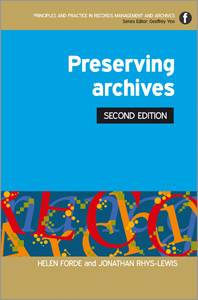Celebrating Preservation Week 2018: an interview with Helen Forde and Jonathan Rhys-Lewis

ALA encourages libraries and other institutions to use Preservation Week to connect our communities through events, activities, and resources that highlight what we can do, individually and together, to preserve our personal and shared collections. In collaboration with Facet Publishing, UK, we spoke with some of the field's leading figures to discuss the importance of preservation. Helen Forde and Jonathan Rhys-Lewis are co-authors of Preserving Archives, now in its second edition.
Why is preservation awareness so important?
The preservation of material culture is crucial for society, for an appreciation of the past and for building blocks for the future. Archival preservation is a massively important part of this, given the crucial role which archives play in holding organizations and individuals to account, in documenting the past and ensuring the survival of corporate memory. Archives provide the structure of the past and without written evidence societies flourish only in the present. Historical examples demonstrate that however powerful a civilization may be, failure to preserve documentary culture eventually results in it being largely forgotten.
Ensuring that communities, government, businesses and individuals are all aware of the essential role of archives is a message that all those involved in the creation and care of written material need to spread widely. Too often, in the current throw-away or careless attitude of society, vital documentary evidence has been lost; this happens in government, in commercial organisations, in legal proceedings and in everyday life. The message which needs to be heard is not that everything should be kept but that the selection of material to be preserved should be carried out logically and consistently to ensure that the full story can be told. Awareness of the material means of then preserving it for current and future use should ideally form part of the initial creation process. The selection of suitable carriers for information - stable inks, quality paper, stable digital platforms - is an essential part of the process of spreading the message about preservation and its importance throughout all societies.
What are some of the ways that libraries and other institutions can reach out to communities about the importance of preservation?
Good practice is often the result of emulation; if libraries, archives, museums, governments and organizations demonstrate their awareness of the importance of archival preservation, others are more likely to follow suit. An understanding of the consequences of neglect and decay can be demonstrated with illustrations of the weakness of poor quality paper, of the solubility of poor quality writing and printing inks and the inherent dangers of not migrating digital information on to stable platforms.
Conservators are good ambassadors for preservation, given that their skills are easily demonstrated and are always appreciated by the public. Any tour of a library, archive or museum can be guaranteed to come to a full stop in a conservation studio where the techniques, for both intervention and prevention, attract attention and lead to discussion. Planning open days and behind the scenes tours are a good way of demonstrating preservation in action, with conservation reserved for specialists.
 Discussion and demonstration sessions held in-house with communities which struggle with the concept of preservation can be useful and demonstrate that it is good practice, rather than expensive additional activity, which contribute to the survival of archival material. Simple packaging with acid free paper or board, strategies for eliminating pests, planning against disasters and training volunteers to handle materials carefully are all possible within many communities and organizations without the expense of intervention techniques by conservators.
Discussion and demonstration sessions held in-house with communities which struggle with the concept of preservation can be useful and demonstrate that it is good practice, rather than expensive additional activity, which contribute to the survival of archival material. Simple packaging with acid free paper or board, strategies for eliminating pests, planning against disasters and training volunteers to handle materials carefully are all possible within many communities and organizations without the expense of intervention techniques by conservators.
In addition, both librarians and archivists, in line with conservators, need to ensure that the professional organizations that represent them are also underlining the importance of preservation in enabling access. Providing information about the risks to materials, and outlining guidance to enable those with important collections to effectively respond to these risks, is also a vital way in which a wider impact can be achieved.
Digital collections are growing fast, and their formats are prone to obsolescence. What are some current or proposed digital collection initiatives from cultural institutions that give you hope for the future?
The challenge of preserving the digital archive is now impacting on all governments, organizations and individuals. The security of information from access and tampering from other agencies is now critical, and so it is vital that appropriate and co-ordinated strategies to address the risks are in place. All citizens understand the importance of data, and especially personal information, and so new legislation, like the General Data Protection Regulation, is integral in defining our digital preservation needs. Alongside this, organizations are responding to the further challenges of technical obsolescence by addressing the needs of the wider community via open source software and working more closely with the hardware and software providers. This is also reflected in the growth of digital specialists in the archive and library worlds, initially prompted by the needs of Freedom of Information, but now building pragmatic roles within organizations.
It seems that finally the world of archives and libraries is acknowledging that it is not possible, or morally and economically sustainable, to digitise all collections. This has resulted in some interesting developments in preservation policy and strategy, but also acknowledges that prioritisation is the key. This may be because of condition, sensitivity or just enabling access to information - the key role of preservation.
Be sure to check out our previous interviews with Michèle Valerie Cloonan and Walker Sampson.
